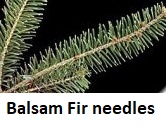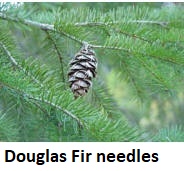Fir Christmas Tree Varieties / Types
Click here for a PDF Print version to take with you to the farm or lot.
(With the PDF, you can print just the table or pages of the trees you like!)
Fir trees are the traditional Christmas tree for most Americans because they have the key qualities: great fragrance, short sturdy needles and branches and good needle retention. If keep watered and not in a hot room, they'll hold their needles up to Christmas.
Firs are on the page below. The summary table below has links to other types of trees. You may also like the automatic tree watering device that looks like a Christmas present, or the plain version. The links for photos and more info open new windows, so just close them to return to this page. Be sure to see the page about how to care for your Christmas tree and prevent needle drop to make your tree last longer!
| Selection Guide to the Most Common Christmas Tree Varieties (ALL trees are described on their pages, click on the links to Tree types - Firs,
Cedars, etc.) |
||||||||||||
| Firs | Pines | Spruces | Cypress | Cedars | Misc | |||||||
| Unusual and Potted | ||||||||||||
| Needle Holding (without water) |
4 | 5 | 5 | 5 | 5 | 3 | 1 | 4 | 4 | 3 | 3 | varies |
| Needle Holding (with water) |
5 | 5 | 5 | 5 | 5 | 4 | 2 | 5 | 4 | 3 | 3 | varies |
| Firmness Branches | 2 | 3 | 3 | 5 | 2 | 4 | 3 | 5 | 2 | 2 | 2 | varies |
| Fragrance | 5 | 5 | 4 | 3 | 4 | 1 | 3 | 3 | 2 | 2 | 4 | varies |
| Needle softness | 5 | 5 | 5 | 2 | 5 | 3 | 3 | 3 | 5 | 3 | 4 | varies |
| Cost | 2 | 3 | 3 | 5 | 4 | 3 | 2 | 1 | 4 | 3 | 3 | varies |
|
|
||||||||||||
Cedars - Cypress - Firs - Pines - Spruce - Miscellaneous
![]()
Firs
Balsam Fir
Photos - 3/4" to 1 and 1/2" short, flat, long lasting needles that are rounded at the tip; nice, dark green color with silvery cast and fragrant. These needles are 3/4 - 1 and 1/2 in. in length and last a very long time.
This is the traditional Christmas tree that most
Americans grew up with. This tree has a dark-green appearance and retains its
pleasing fragrance throughout the Christmas season.

Named for the balsam or resin found in blisters
on bark. Resin is used to make microscope slides and was sold like chewing gum;
used to treat wounds in Civil War.

Canaan Fir
Photos - Similar to the other eastern firs.
Abies balsamea phanerolepi. It is very similar to balsam fir, and was once thought to be the same, but has been since determined to be a distinct species.
Canaan Fir has short, soft needles that are dark green on the upper surface and silvery blue on the underside.
It combines
the strong fragrance of the Balsam Fir with the better needle retention of the
Fraser Fir. 
It is native to isolated pockets in the mountains of West
Virginia and Virginia, but is commercially grown in many areas of the east
Coast and now the Midwest.

Douglas Fir
Larger photos - good fragrance; holds blue to dark green; 1" to 1 and 1/2" needles; needles have one of the best aromas among Christmas trees when crushed.
 The Douglas fir
needles radiate in all directions from the branch. When crushed, these
needles have a sweet fragrance.
The Douglas fir
needles radiate in all directions from the branch. When crushed, these
needles have a sweet fragrance.
They are one of the top major Christmas tree species in the U.S. Named after David Douglas who studied the tree in the 1800's; good conical shape; can live for a thousand years.
Fraser Fir - Larger photos
- dark green, flattened
Larger photos
- dark green, flattened needles; 1/2 to 1 inch long, dark
green on the top and silvery underneath; good needle retention; nice scent; pyramid-shaped
strong branches which turn upward. The Fraser fir branches turn slightly upward.
They have good form and needle-retention. They are dark blue-green in color.
They have a pleasant scent, and excellent shipping characteristics as well. Named for a botanist, John Fraser Fir, who
explored the southern Appalachians in the late 1700's. The only grow in cooler climates; north of Georgia, for example. In borderline areas, like North
Carolina, Fraser firs only grow at higher elevations, 4,500 feet or above. They can grow on north-facing slopes, though, as low as 2,300 feet elevation.
needles; 1/2 to 1 inch long, dark
green on the top and silvery underneath; good needle retention; nice scent; pyramid-shaped
strong branches which turn upward. The Fraser fir branches turn slightly upward.
They have good form and needle-retention. They are dark blue-green in color.
They have a pleasant scent, and excellent shipping characteristics as well. Named for a botanist, John Fraser Fir, who
explored the southern Appalachians in the late 1700's. The only grow in cooler climates; north of Georgia, for example. In borderline areas, like North
Carolina, Fraser firs only grow at higher elevations, 4,500 feet or above. They can grow on north-facing slopes, though, as low as 2,300 feet elevation.

Grand Fir - Photos - shiny, dark green needles about 1" - 1 and 1/2" long; the blunt needles when crushed, give off a citrusy smell. They are yellowish-green on top surface with white bands on underside. The needles alternate in two lengths (on each tree) alternating longer and shorter which gives the branches a fuller look. Unlike the Douglas fir, Grand Fir needles are aligned in the same plane coming off the branch. Grand Firs commonly grow only on the Pacific northwest coast.
The Grand Fir is related to the
white fir, and is also called the great silver fir, western white
fir, Vancouver fir, or Oregon fir. It mostly grows at altitudes from
sea level to 1,800 m. 
Noble Fir - one inch long, bluish-green needles with a silvery appearance; has short, stiff branches; great for heavier ornaments; keeps well.
These needles turn upward, exposing the lower branches.
Its extremely aromatic, and while
it is native to the West Coast, it is gaining popularity throughout the U.S.

Its shape is similar to a Douglas fir but with a deeper, richer green. Known for its beauty,
the noble fir has a long keep ability, and its stiff branches make it a good
tree for heavy ornaments, as well as providing excellent greenery for wreaths
and garland.
Nobles are native to the Pacific northwest coast; the Siskiyou Mountains
of northern California and the Cascade and Coastal ranges of Oregon and
Washington. It closely resembles the California red fir

Nordmann Fir -
Larger Photo. An excellent needle retaining species with soft glossy dark green
needles. Nordmann Firs are the preferred Christmas tree of Europeans, with long,
full, lush, dark green foliage, similar to a Fraser fir, but soft to the touch
and with excellent needle retention. Nordmann Fir Christmas Trees can
reach 60 feet in height with a spread of 25 to 30 feet. Their soft and lustrous
black-green needles  stem from symmetrically arranged branches, producing the
ideal pyramidal specimen for a Christmas tree. Nordmann Firs are also popular as
ornamental trees in parks and gardens. This tree is very popular in Great Britain.
Wikipedia has more information
and does
this grower's website.
stem from symmetrically arranged branches, producing the
ideal pyramidal specimen for a Christmas tree. Nordmann Firs are also popular as
ornamental trees in parks and gardens. This tree is very popular in Great Britain.
Wikipedia has more information
and does
this grower's website.
See the photo at right.
 Turkish
Fir, also called Trojan Horse Fir -
Turkish
Fir, also called Trojan Horse Fir -
The Trojan Horse Fir is native to Eastern Turkey. It grows large with dark green
foliage accented by the blue undersides of the needles. The needles are longer, thicker, and more shiny than
Fraser Fir's.
White Fir or Concolor Fir - larger photo -
White Fir has blue-green needles, with a whitish tint, are 1/2 to 1/2 inches long; n ice shape and good aroma, a citrus
scent; good needle retention.
ice shape and good aroma, a citrus
scent; good needle retention.
They have good foliage color, good needle retention, and a pleasing shape and aroma. This variety has a dedicated following.
In nature can live to 350 years.
Potted Christmas trees
Potted Christmas trees

Norfolk Island Pine
A tree from the tropics, these make a great houseplant AND they look great decorated as a Christmas tree.
- See this page for more information about Norfolk Island Pines.
- And this page has information about tropical trees of Florida .
Australians occasionally use a native plant called Australian Christmas tree, (Nuytsia floribunda, aka moodjar) as a living Christmas tree.
For Easter egg Hunts, Children's Consignment Sales, Local Farm Markets and other types of Farms, click here.
Find Other types of farms:
- Farm markets and roadside stands
- Road trips and camping resources
- Home canning supplies at the best prices on the internet!
- Maple Syrup Farms, sugarworks, maple syrup festivals
- Environmental information and resources
- Consumer fraud and scams information
- Farms For Your Event for birthday parties, weddings, receptions, business meetings, retreats, etc.
- Pick Your Own fruits and vegetable farms
- Festivals - local fruit and vegetable festivals
- Local Honey, apiaries, beekeepers
- Local Meat, Milk and Eggs
Get the
most recent version of
the Ball Blue Book
Find Other types of farms:
- Farm markets and roadside stands
- Road trips and camping resources
- Home canning supplies at the best prices on the internet!
- Maple Syrup Farms, sugarworks, maple syrup festivals
- Environmental information and resources
- Consumer fraud and scams information
- Farms For Your Event for birthday parties, weddings, receptions, business meetings, retreats, etc.
- Pick Your Own fruits and vegetable farms
- Festivals - local fruit and vegetable festivals
- Local Honey, apiaries, beekeepers
- Local Meat, Milk and Eggs
Get the
most recent version of
the Ball Blue Book

